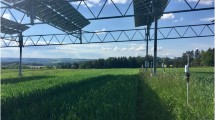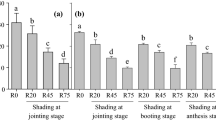Abstract
Despite the steadily increasing area under protected agriculture there is a current lack of knowledge about the effects of the 30% black shading screen on microclimate and crop water requirements. Meteorological and lysimeter measurements inside a screenhouse planted with sweet pepper were compared to external reference data. Irrigation water use efficiency (IWUE) was calculated from yield records Y and water meter readings I applied. Shading reduced mean global radiation R G by more than 40%, and the screen transmissivity τ screen was shown to vary with solar elevation angle β. Wind speed inside the screenhouse u in was reduced by more than 50%. Crop water requirements ET c were 38% lower than estimates for an open field crop, suggesting a significant water saving potential when using screenhouses. However, the screen did not significantly modify maximum temperature T max and daily vapor pressure deficit. The FAO-Penman–Monteith approach based on meteorological measurements in the screenhouse accurately predicted daily crop evapotranspiration, and was in close agreement with lysimeter measurements. IWUE was relatively high (10.7 kg m−3 in 2004 and 13.5 kg m−3 in 2005), but additional research is required to quantify the effect of shading on yield as well as to determine the water saving potential of other commonly used screens.










Similar content being viewed by others
References
Allen RG, Pereira LS, Raes D, Smith M (1998) Crop evapotranspiration. Guidelines for computing crop water requirements. FAO irrigation and drainage paper 56, Rome
Avnimelech Y, Klein D, Wallach R (1992) Irrigation with sewage effluents: the Israeli experience. In: Shalhevet J, Changming L, Yueaxian X (eds) Water use efficiency in agriculture. Proceedings of the binational China–Israel workshop, Beijing. Priel Publishers, Rehovot, 22–26 April 1991, pp 286–297
Ayers RS, Westcot DW (1985) Water quality for agriculture. FAO irrigation and drainage paper no. 29, UN-FAO, Rome, Italy
Campbell GS, Norman JM (1998) An introduction to environmental biophysics, 2nd edn. Springer, Berlin Heidelberg New York, pp 239–246
Desmarais G (1996) Thermal characteristics of screenhouse configurations in a West-African tropical climate. PhD Thesis, McGill University
Desmarais G, Ratti C, Raghavan G (1999) Heat transfer modeling of screenhouses. Sol Energy 65:271–284
Doorenbos J, Kassam AH (1979) Yield response to water. FAO irrigation and drainage paper no. 33. UN-FAO, Rome, Italy
Esquira I (2006) Personal communication
Fuchs M, Stanhill G (1977) The relative flux density of photosynthetically active radiation. J Appl Ecol 14:317–322
Fuchs M, Dayan E, Shmuel D, Zipori I (1997) Effects of ventilation on the energy balance of a greenhouse with bare soil. Agric For Meteorol 86:273–282
Hartz TK, Costa FJ, Schrader WL (1996) Suitability of composted green waste for horticultural uses. Hortscience 31:961–964
Hodges L, Sanders DC, Perry KB, Batal KMD Granberry DM, McLaurin WJ, Decoteau D, Dufault RJ, Garrett JT, Nagata R (1995) Adaptility and reliability of yield of four bell pepper cultivars across three Southeastern States. Hortscience 30:1205–1210
James LG (1988) Farm irrigation system design. Wiley, New York
JMP (2002) Version 5.0.1. SAS Institute Inc., Cary, NC, 1989–2002
Kadayifci A, Tuylu GI, Ucar Y, Cakmak B (2005) Crop water use of onion (Allium cepa L.) in Turkey. Agric Water Manage 72:59–68
Möller M (2002) The effect of insect-proof nets on exchange of mass and momentum in a screenhouse for pepper cultivation in central Israel. Diploma Thesis, Department of Meteorology, TU Dresden
Möller M, Tanny J, Cohen S, Teitel M (2003) Micrometeorological measurements in a screenhouse. Acta Hortic 614:445–451
Möller M, Tanny J, Li Y, Cohen S (2004a) Measuring and predicting evapotranspiration in an insect-proof screenhouse. Agric For Meteorol 127:35–51
Möller M, Tanny J, Cohen S, Li Y, Grava A (2004b) Water consumption of pepper grown in an insect proof screenhouse. Acta Hortic 659:569–575
Monteith JL, Unsworth MH (1990) Principles of environmental biophysics, 2nd edn. Butterworth-Heinemann, Oxford, p 255
Posalski I (2006) Personal communication
Raveh E, Cohen S, Raz T, Yakir D, Grava A Goldschmidt EE (2003) Increased growth of young citrus trees under reduced radiation load in a semi-arid climate. J Exp Bot 54:365–373
Rilsky A, Adamati A (1989) Pepper (in Hebrew) pp. 260–291. In: Arnon I, Meller S, Margelit IM, Lipschitz C (eds) The encyclopedia of agriculture, vol 5. Nidet Publications Ltd., Tel Aviv
Ross DS, Gill SA (1994) Insect screening for greenhouses. Information facts. FACTS 186 College Park, University of Maryland
Rossel H, Ferguson J (1979) A new economical screenhouse for virus research in tropical areas. FAO Plant Protect Bull 27:74–76
Sezen SM, Yazar A, Eker S (2006) Effect of drip irrigation regimes on yield and quality of field grown bell pepper. Agric Water Manage 81:115–131
Shannon EL, McDougall A, Kelsey K, Hussey B (1996) Watercheck—a coordinated extension program for improving irrigation efficiency on Australian cane farms. Proc Aus Soc Sugar Cane Tech 18:113–118
Stanhill G (1992) Irrigation in Israel: past achievements, present challenges and future possibilities. In: Shalhevet J, Changming L, Yueaxian X (eds) Water use efficiency in agriculture. Proceedings of the binational China–Israel workshop, Beijing, China, Priel Publishers, Rehovot, 22–26 April 1991, p 63–77
Stanhill G, Moreshet S, Fuchs M (1976) Effect of increasing foliage and soil reflectivity on the yield and water use efficiency of grain sorghum. Agron J 68:865–871
Tanny J, Cohen S, Teitel M (2003) Screenhouse microclimate and ventilation: an experimental study. Biosyst Eng 84:331–341
Teitel M, Segal I (1995) Net thermal radiation under shading screens. J Agric Eng Res 61:19–26
Teitel M, Peiper UM, Zvieli Y (1996) Shading screens for frost protection. Agric For Meteorol 81:272–286
Waggoner P, Pack A, Reifsnyder W (1959) The climate of shade, a tobacco tent and a forest stand compared to open fields. The Connecticut Agricultural Research Station, Bulletin 626
Yerek (2006) The vegetable crop council. Online: www.yerek.co.il (in Hebrew). Last accessed: 6 July 2006
Zhao Y, Teitel M, Barak M (2000) Vertical temperature and humidity gradients in a naturally ventilated greenhouse, J Agric Eng Res 61:1–6
Acknowledgments
The authors wish to thank Dr. S. Cohen, Dr. E. Raveh, A. Grava, K. Narkis and E. Matan and the staff at the Besor Experimental Research Station for their support and the two anonymous reviewers and Prof. S. Stanhill for their critical review of the manuscript. This work was funded by the US Agency for International Development through CDR Grant no. TA-MOU−01-C21-019.
Author information
Authors and Affiliations
Corresponding author
Additional information
Communicated by A. Kassam
Contribution no. 603/06 from the Agricultural Research Organization
An erratum to this article can be found at http://dx.doi.org/10.1007/s00271-006-0048-6
Rights and permissions
About this article
Cite this article
Möller, M., Assouline, S. Effects of a shading screen on microclimate and crop water requirements. Irrig Sci 25, 171–181 (2007). https://doi.org/10.1007/s00271-006-0045-9
Received:
Accepted:
Published:
Issue Date:
DOI: https://doi.org/10.1007/s00271-006-0045-9




